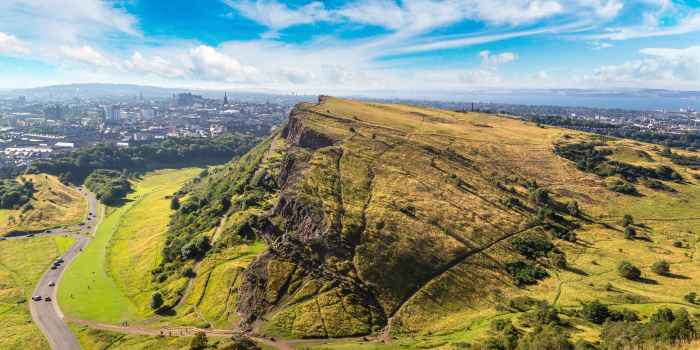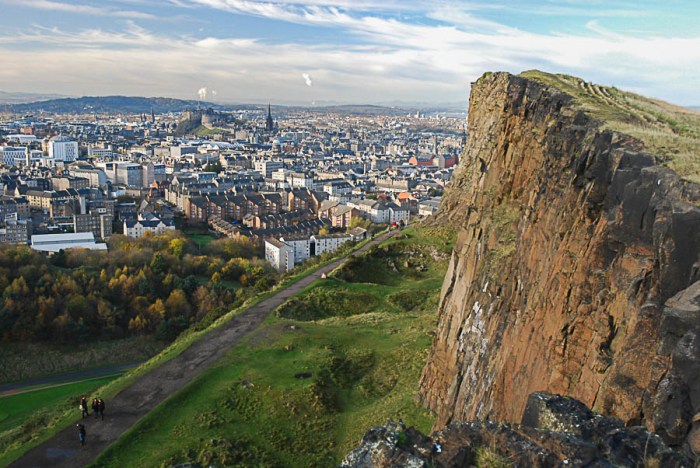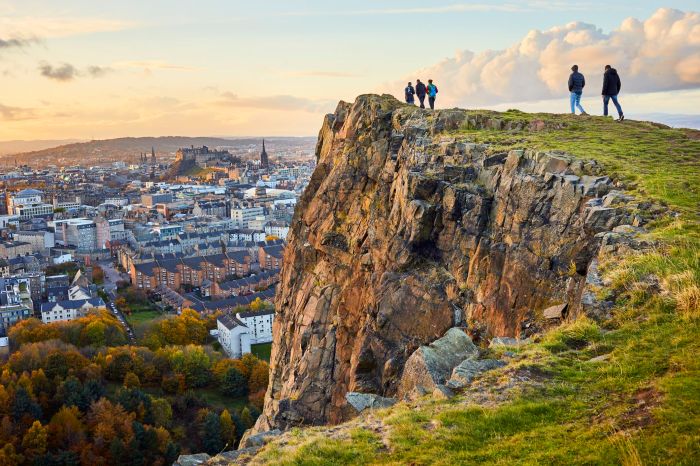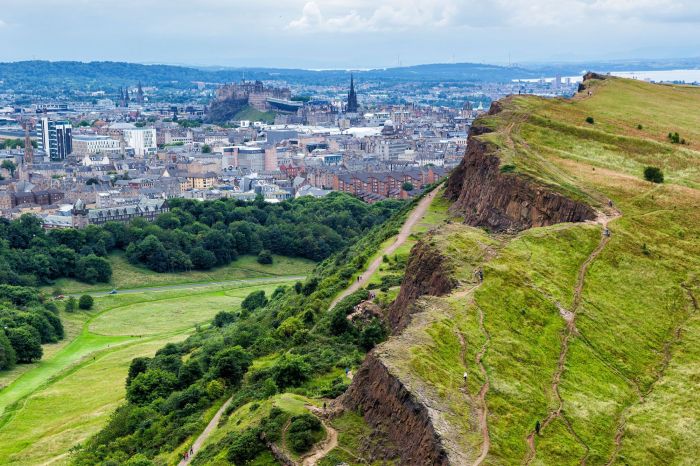Arthurs seat – Arthur’s Seat, an iconic landmark that towers over Edinburgh, Scotland, is a captivating blend of geological wonder and historical significance. Formed by a series of volcanic eruptions millions of years ago, this majestic hill offers breathtaking views, diverse flora and fauna, and a rich tapestry of cultural and recreational opportunities.
From its volcanic origins to its role in Scottish history and its status as a beloved recreational destination, Arthur’s Seat stands as a testament to the enduring power of nature and the enduring spirit of the human experience.
Introduction

Arthur’s Seat is an iconic landmark that dominates the Edinburgh skyline. It is a volcanic hill with a distinctive, rugged appearance and is the highest point in the city. Arthur’s Seat is a popular tourist destination, offering stunning views of the city and surrounding area.
Arthurs Seat, a dormant volcano in Edinburgh, offers breathtaking views of the city and the surrounding countryside. If you’re looking for a more serene natural experience, consider visiting the arboretum dallas , which boasts a vast collection of trees and plants from around the world.
Afterward, return to Arthurs Seat to soak in the stunning panorama once more.
The hill was formed around 350 million years ago during the Carboniferous period. It is composed of volcanic rock, which was formed when magma cooled and solidified. Arthur’s Seat is part of the Pentland Hills, a range of hills that runs through southern Scotland.
Historical Importance
Arthur’s Seat has a long and varied history. It has been used as a fort, a royal hunting ground, and a place of worship. In the 12th century, the Normans built a castle on the summit of the hill, which was later destroyed by the Scots. In the 16th century, the hill was used as a gunpowder store by the English. Today, Arthur’s Seat is a popular tourist destination and a popular spot for picnics and walks.
Arthur’s Seat is a must-visit landmark in Edinburgh, offering stunning panoramic views of the city. For those seeking more outdoor adventures, a trip to Antrim is highly recommended. This beautiful county in Northern Ireland boasts the iconic Giant’s Causeway, a UNESCO World Heritage Site renowned for its unique hexagonal basalt columns.
Upon returning to Edinburgh, don’t miss the opportunity to climb to the summit of Arthur’s Seat for a breathtaking sunset over the Scottish capital.
Geological Features

Arthur’s Seat’s origins lie in a series of volcanic eruptions that occurred during the Carboniferous period, around 350 million years ago. These eruptions created a landscape of lava flows and volcanic vents, which have since been eroded by glaciers and other natural forces to form the hill we see today.
The hill is composed of various rock types, including basalt, dolerite, and sandstone. Basalt is a dark, fine-grained rock that forms from the rapid cooling of lava. Dolerite is a coarser-grained rock that forms when lava cools more slowly. Sandstone is a sedimentary rock that is formed from the accumulation of sand grains.
Volcanic Origins
Arthur’s Seat is the remains of an ancient volcano that was active during the Carboniferous period. The volcano erupted a series of lava flows that built up to form the hill. The lava flows are visible today as the dark bands of rock that run through the hill. The volcano also produced a number of volcanic vents, which are now filled with dolerite. These vents can be seen as the small, round hills that dot the landscape of Arthur’s Seat.
Rock Types
The rock types found on Arthur’s Seat reflect the hill’s volcanic origins. Basalt is the most common rock type, and it forms the majority of the hill’s surface. Dolerite is also common, and it is found in the volcanic vents. Sandstone is found in the lower slopes of the hill, and it was deposited by rivers and glaciers during the Ice Age.
Landscape
The geological features of Arthur’s Seat have shaped the hill’s distinctive landscape. The lava flows have created a series of ridges and valleys, while the volcanic vents have formed small, round hills. The sandstone has been eroded by glaciers and rivers to create the lower slopes of the hill. The result is a landscape that is both beautiful and geologically interesting.
Historical Significance

Arthur’s Seat has played a significant role in Scottish history, dating back to the Iron Age when it was used as a hillfort. The hill has been associated with King Arthur and the Knights of the Round Table, lending it a legendary status.
Archaeological Remains
The hilltop is home to various archaeological remains, including the ruins of St. Anthony’s Chapel, which dates back to the 15th century. Excavations have also uncovered evidence of prehistoric settlements, such as hut circles and midden heaps, indicating human habitation on the hill for thousands of years.
Cultural Significance
These historical events and associations have contributed to the hill’s cultural significance. Arthur’s Seat is a popular tourist destination, and its historical significance adds to its appeal. The hill’s iconic status has also inspired numerous works of art, literature, and music, further cementing its place in Scottish culture.
Natural Environment

Arthur’s Seat boasts a remarkable diversity of flora and fauna, making it a vibrant natural haven within the urban landscape. Its unique plant communities and birdlife contribute to its ecological significance.
The hill’s varied habitats support a wide range of plant species, including over 400 species of vascular plants and numerous mosses and lichens. Heather moorland, grasslands, and woodland areas create a mosaic of ecosystems. Gorse, broom, and heather dominate the moorland, while grasslands provide grazing for sheep and cattle.
Flora
- Over 400 species of vascular plants
- Heather moorland, grasslands, and woodland areas
- Gorse, broom, and heather in the moorland
- Grazing sheep and cattle in the grasslands
Arthur’s Seat is also home to a rich birdlife. Peregrine falcons, kestrels, and buzzards soar above the hill, while skylarks, meadow pipits, and stonechats fill the air with their songs. The diverse habitats provide nesting and feeding grounds for many species.
Fauna
- Peregrine falcons, kestrels, and buzzards
- Skylarks, meadow pipits, and stonechats
- Diverse habitats for nesting and feeding
As a green space within Edinburgh, Arthur’s Seat provides invaluable recreational and environmental benefits. It offers residents and visitors a place to escape the hustle and bustle of the city, enjoy fresh air, and connect with nature. The hill’s diverse habitats contribute to air and water purification, carbon sequestration, and the regulation of local climate.
Conservation efforts are ongoing to protect the natural environment of Arthur’s Seat. The hill is designated as a Site of Special Scientific Interest (SSSI) and is managed by the City of Edinburgh Council. Maßnahmen include habitat restoration, invasive species control, and public education programs to raise awareness about the hill’s ecological importance.
Arthurs Seat, an extinct volcano with breathtaking views of Edinburgh, is a must-visit for families seeking adventure. For more family-friendly destinations, explore our guide to the best family vacation spots. Discover hidden gems, thrilling activities, and unforgettable experiences that will create lasting memories for your loved ones.
Don’t miss the opportunity to conquer Arthurs Seat’s iconic peak, offering panoramic vistas that will leave you in awe.
Conservation Efforts
- Designated as a Site of Special Scientific Interest (SSSI)
- Managed by the City of Edinburgh Council
- Habitat restoration, invasive species control
- Public education programs
Cultural and Recreational Significance

Arthur’s Seat holds immense cultural and recreational significance for the people of Edinburgh and visitors alike. It serves as a backdrop for various cultural events and is a popular destination for outdoor enthusiasts.
Cultural Events, Arthurs seat
Arthur’s Seat is a central feature in Edinburgh’s cultural landscape. It is the site of the annual Beltane Fire Festival, a vibrant celebration of Celtic culture and the arrival of summer. During the festival, a large bonfire is lit on the hilltop, accompanied by music, dance, and performances.
The hill is also a popular venue for the Edinburgh Fringe Festival, the world’s largest arts festival. During the festival, numerous performances and exhibitions take place on and around Arthur’s Seat, showcasing a diverse range of artistic talents.
Recreational Destination
Arthur’s Seat is a beloved recreational destination for locals and tourists. The hill offers a range of activities for outdoor enthusiasts, including hiking, climbing, and sightseeing.
The hilltop provides breathtaking panoramic views of Edinburgh and the surrounding area. Visitors can enjoy stunning vistas from various viewpoints, including the summit, the Lion’s Head, and the Radical Road.
Last Word

Arthur’s Seat is more than just a hill; it is a symbol of Edinburgh, a testament to the city’s geological and historical heritage, and a beloved destination for locals and visitors alike. Whether you’re seeking breathtaking views, a glimpse into the past, or simply a chance to connect with nature, Arthur’s Seat offers an unforgettable experience that will stay with you long after your visit.
Detailed FAQs: Arthurs Seat
How was Arthur’s Seat formed?
Arthur’s Seat was formed by a series of volcanic eruptions that occurred over millions of years.
What is the highest point on Arthur’s Seat?
The highest point on Arthur’s Seat is the summit, which is 251 meters (823 feet) above sea level.
Is Arthur’s Seat a popular tourist destination?
Yes, Arthur’s Seat is a popular tourist destination, attracting visitors from all over the world.